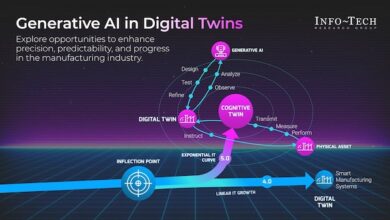Eye on AI: how can we keep this life-changing tech on an ethical course?

In our ‘Eye on AI’ series, we’ve seen how the democratization of generative AI is creating better user experiences, empowering advertisers and enhancing partnerships. In this final part of the series, we explore how generative AI’s ongoing evolution can be guided as responsibly as possible.
We’re at the start of a thrilling and life-changing information and communication revolution. AI is giving us all the opportunity to do more, with less, whether we’re at work or at play.
But we have only just scratched the surface with what’s possible. So, what’s next for this technology – and how could it continue to enhance and reshape our industries and our lives in a responsible way?
Changing the world, for all
Generative AI has the potential to change the world. But with great change comes great responsibility. As Microsoft Advertising’s regional vice-president, Ravleen Beeston says: “Together, we must ensure that technology is used for the good of society, and every individual who engages with it.”
As generative AI’s influence becomes more mainstream, responsible practices become increasingly crucial. For example, Microsoft outlines six key principles for responsible AI, built around the guiding principles of ethics and explainability: accountability, inclusiveness, reliability and safety, fairness, transparency, and privacy and security.
From an ethical perspective, AI should be fair and inclusive in its assertions, be accountable for decisions and not discriminate or hinder different races, disabilities or backgrounds. Explainability helps data scientists, auditors, and business decision makers ensure that AI systems can justify their decisions and how they reach their conclusions, while also ensuring compliance with company policies, industry standards and government regulation.
Making purposeful marketing easier
Generative AI use in advertising introduces the possibility of creating more diverse and inclusive content, to make it accessible to everyone. According to research and prompt skills training by Microsoft which identified the top 50 words that signal inclusion, the most effective inclusive prompts are based around metaphors denoting connection, openness and balance, feelings of joy and trust, dimensions of diversity and inclusive product features.
Using these inclusive prompts when working with generative AI tools makes it easier to create a spectrum of content types for different audiences and to personalize product messages in a way that resonates with each consumer’s individual needs, expectations and hopes.
It’s little wonder, then, that inclusive advertising has been shown to significantly enhance brand trust, loyalty, and revenue growth, boosting customer purchase intent by as much as 23-points.
The impact on our future
As generative AI continues to free up the workforce from time-intensive processes and boosts productivity, leaders will need to reimagine how to run their business, to harness its potential. New skills will emerge as human expertise will be needed to fine-tune AI models, analyze results and integrate this technology into existing processes. As organizations look to upskill their teams and educate them on the importance and responsible use of generative AI, fostering trusted partnerships with knowledgeable solutions providers, like Microsoft, will be key.
Generative AI represents a huge opportunity for all of us, creating new value with real purpose. It creates opportunities for advertisers, drives monetization for publishers and delights consumers. Whatever the changes to come, though, today’s guiding principle will remain the same: power up the tech by being human-led. Humans are the pilot, and these tools are here to enhance our lives, at work and at play, now and in the future.
For a full recap of our Eye on AI series, visit here.



